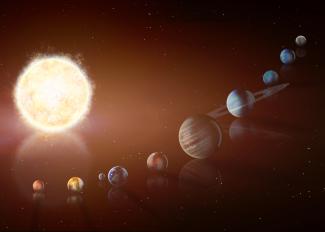
Instructions
Do the preparation task first to help you with the difficult vocabulary. Then read the article and do the exercises to check your understanding.
A planet the size of Jupiter has been discovered and it is one of the hottest ones known to us. This has made scientists think about how planets are formed.
Heat signature
Planets such as Earth have more oxygen than carbon, but what if the composition was reversed? This is a question opened up by a recent discovery of a 'diamond planet' by US and UK scientists, led by Nikku Madhusudhan of the Massachusetts Institute of Technology, and including researchers from Belfast’s Queens University and the University of Warwick. The planet is 1200 light years away from Earth and was observed using NASA's Spitzer Space Telescope. Dr Marek Kukula of the Royal Greenwich Observatory in London, whose role is to interpret and comment on astronomical discoveries made by British scientists, explained that researchers initially used the SuperWASP (Wide Angle Search for Planets) robotic observatories operating continuously, all year around. They detected the planet, then it was observed with the Spitzer Space telescope, which according to Dr Kukula 'detected the heat coming from the planet, and from that heat signature they can tell what this planet is made from'.
Giant planet
The planet is very different to Earth. ‘It’s a giant planet,’ explains Dr Kukula, ‘a gas planet, a bit like Jupiter in our solar system. But the interesting thing that they’ve discovered is that it has a very different composition to the planets in our solar system. So where our planets have a half fraction of oxygen then carbon, this planet has it the other way around, it has more carbon than oxygen.’ This suggests that there is more than one way to make a solar system and the range of planets in the universe could be much wider than previously thought.
Diamonds and graphite
Dr Kukula says that if there are smaller planets in the same solar system with a similar composition, rich in carbon, their rocks could be rich in minerals such as carbon and diamonds, unlike Earth which has silica, the sand that rocks on Earth are made from. ‘This is where this diamond planet idea comes from; they haven’t actually detected a diamond planet yet,’ explains Dr Kukula. It’s hypothetical, ‘but you can imagine strange landscapes with black graphite rocks lying around and the surface could be covered with sticky liquids instead of water.’
How interested are you in outer space? Do you think that there may be life on other planets?

Comments